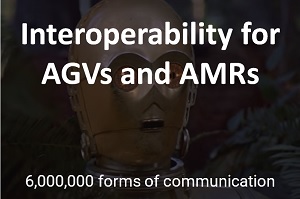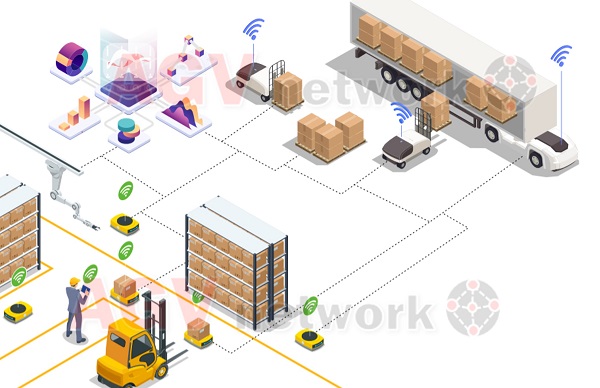What is VDA 5050? A Game-Changer in AMR-AGV Communication
 5 years ago a customer asked me if we could supply a management system able to handle different types and brands of mobile robots… the answer was: ❌ No, I’m sorry. It is not possible.
5 years ago a customer asked me if we could supply a management system able to handle different types and brands of mobile robots… the answer was: ❌ No, I’m sorry. It is not possible.
Now, interoperability is irrupting in the mobile robot world. It will become the new normal.
Why is VDA5050 for AGVs and AMRs a must?
Simply put, interoperability is the capacity of mobile robots to communicate/interact with other elements in the system.
From a wide perspective, we could consider three interoperability levels:
✅ Capacity to interact with external Systems (ERP, WMS,IoT, etc)
✅ Capacity to interact with human processes
✅ Ability to manage heterogeneous mobile robot fleets
In this article I will focus on the third point. If you wish to know more about the whole interoperability concept you can check this article: AMR Interoperability a Must Go for the future
So from the fleet management perspective, an interoperable system is able to communicate and coordinate with different robots under the same “orchestration” umbrella. ????♂️
???? To be honest… Star Wars C3PO twas able to communicate in over 6 million form of communication… he’s the father of interoperability.
Today, there are many different Automated Guided Vehicles and Autonomous Mobile Robots Manufacturers offering vehicles and technology to the market.
Typically, these AGVs and AMRs do only work with their own specific fleet management software. As soon as you wish to have mobile robots from more than one supplier… you will face some complex challenges.
You will face these problems (and many others):
❓Who sends missions to all the robots?
❓Who’s in charge of traffic management?
❓Can two different suppliers work in the same area?
❓Who’s responsible for what?

It makes sense… If I were a customer, I would ask my suppliers to have a system able to be controlled by my own central system or a third party system.
Doing this way, I would not be bounded to a certain technology or manufacturer.
|
Those manufacturers who do not make interoperability native to their systems will probably face hard times because either a 3rd party will sell a solution that takes away software side sales of their product line or manufacturers with native interoperability will be selected over them. |
No one knows what new product will come along or from what manufacturer.
It is a good bet that your management system and robots can be easily integrated into the existing control architectures.
Another important point relates to companies regularly acquiring other companies or their divisions. These companies, would prefer interoperable systems to work together as changes in the economics require assets to be moved between locations to meet business needs.
⚠⚠ ATTENTION AGV and AMR manufacturers…. Mobile Robot interoperability will become a must in the next coming years ????. So be ready to adapt your systems or you’ll be kicked off from the “big arenas”. ????♀️
But where are we now? We’re still in an early stage. ????.
What is the VDA 5050?
The VDA5050 is a standardized interface to allow communication between different mobile robots, so AGV and AMR, and a central management software.
The target of VDA5050 is to enable every compliant mobile robot to work together using one and common fleet management software, rather than different master controllers and software from each brand working on-site.
The VDA 5050 is the European attempt to mobile robot interoperability. It is possible thanks a collaboration between the German Association of the Automotive Industry (VDA) and the VDMA Materials handling and Intralogistics Association.
You can find documentation needed to implement the VDA 5050 standard on GitHub.
What is the MassRobotics Interoperability platform?
In the US, MassRobotics is leading the trend. The concept is the same.
I just directly copy-paste from the MassRobotics web:
The group’s mission is to develop standards that will allow organizations to deploy autonomous mobile robots (AMRs) and other automation equipment from multiple vendors and have them work together in the same environment, better realizing the promise of warehouse and factory automation.
These standards will allow robots of different types to share status information and operational conventions or “rules of the road” so they can better coexist on a warehouse or factory floor.
If you want to know more, just check these two links:
The AMR Interoperability Standard 1.0 was released May 18, 2021. You can view the press release here.
You can find documentation needed to implement the standard on GitHub.
What are the main AGV and AMR Interoperability challenges
From a customer's initial perspective it makes a lot of sense, why be tied to a single vendor and if the market can be commoditized? Sounds easy and win-win right?
Although the base has been established today (like VDA 5050 or MassRobotics), if we look deeper there is still a long way to go to fully achieve this milestone.
From the technical point of view, there are some discussions, for example how to consolidate robot-based planning vs fleet manager-based planning, how to manage different maps and configurations etc.
Moreover, not all the data available in a typical fleet management system has been standardized yet, I’m talking about:
- What data can be exchanged between two AMR systems
- Remote access to each AMR‘s status, view error logging , status of interlocks with other automation systems like conveyors robots
- etc
Interoperability implies several commercial or contractual challenges too, which are not always apparent.
For example, who is responsible for system performance? Is the all-encompassing fleet manager supplier liable for damages if the availability dips below 99% even though they are not the robot builders? Or should it be the robot builders responsibility even though they did not design the fleet manager?
Think about longevity. Many industrial systems are expected to last more than10 years. What happens when the fleet manager supplier goes bankrupt and now the customer has a 5 year old system that grinds all operations to a halt?
It would be a less severe scenario if the specific system supplier was only confined to one part of the operation and not the whole operation.
In this scenario, 3rd party agnostic cloud based systems are already burgeoning providing.
There are several cloud-based robotic platforms supplying tools for system integrators and 3PLs.
These platforms are offer out-of-the-box connectivity for a growing types and manufacturers of different WMS, AMRs, conveyors, barcode scanners, photo eyes and more.
|
Do not miss this article: Cloud WMS Software These 11 Advantages Will Change Your Mind |
Benefits of Robotics Interoperability
First, the most evident: one single platform where user can control, manage and track the overall system performance.
Thanks to AI, the orchestration of different systems will even be optimized constantly resulting in better utilization and higher throughput of transports or consequently less means (vehicles, wearables, robotic cells, etc). It means enhanced tools of traffic control, task management, and smart routing.
When complexity and interoperability of AGV systems raises, it is essential to have good analytics.
A central management tool can gather all the data from the different systems creating a huge amount of data that could be used to improve the overall operations.
All the small problems can be identified and fixed quickly. An independent third party platform helps to have real-time anomaly detection giving transparent info about these anomalies and helps to identify how do these anomalies affect the whole system.
Conclusions
Interoperability is a core focus point with the target to provide universal protocols that allow mobile robot users to manage their fleets seamlessly and efficiently from one central place.
The robotics industry will definitely be reaping the benefits of such combined forces in the near future ????
It’s exciting to see where this revolution of robotics interoperability will take us ????
|
Related articles
What is a Laser Guided Vehicle?
|
 Written by Alfredo Pastor Tella (agvnetwork editor).
Written by Alfredo Pastor Tella (agvnetwork editor).
Follow me on LinkedIn... let's create a mobile robot community to discuss and learn about these outstanding systems.


